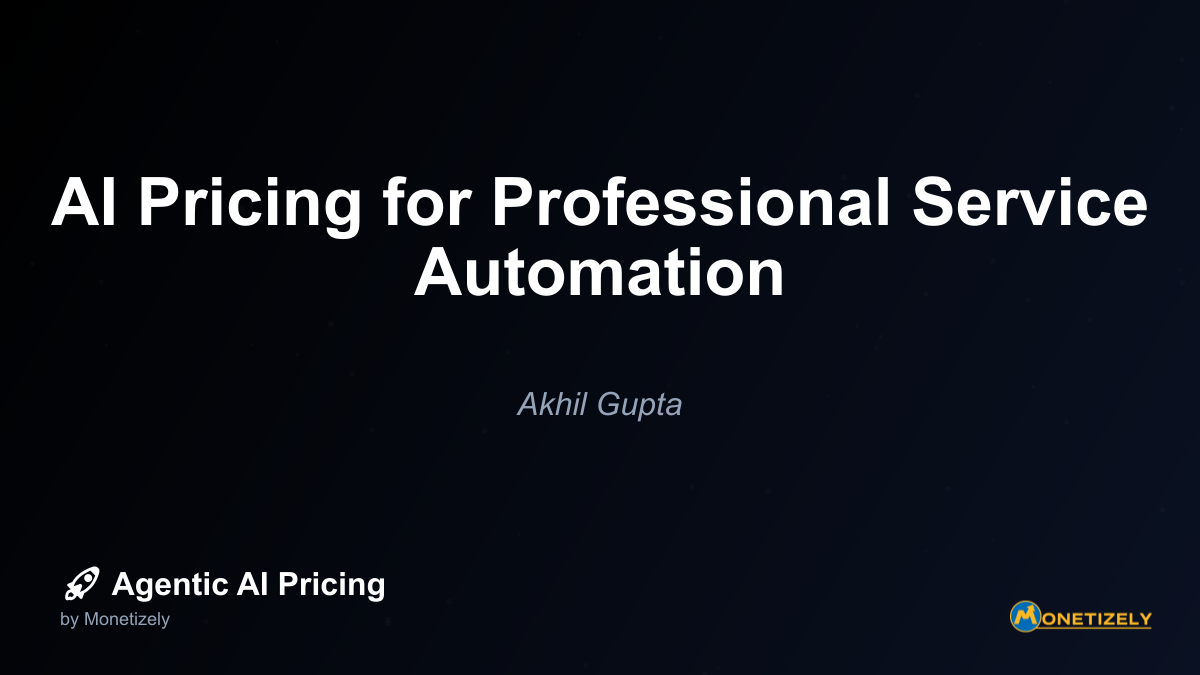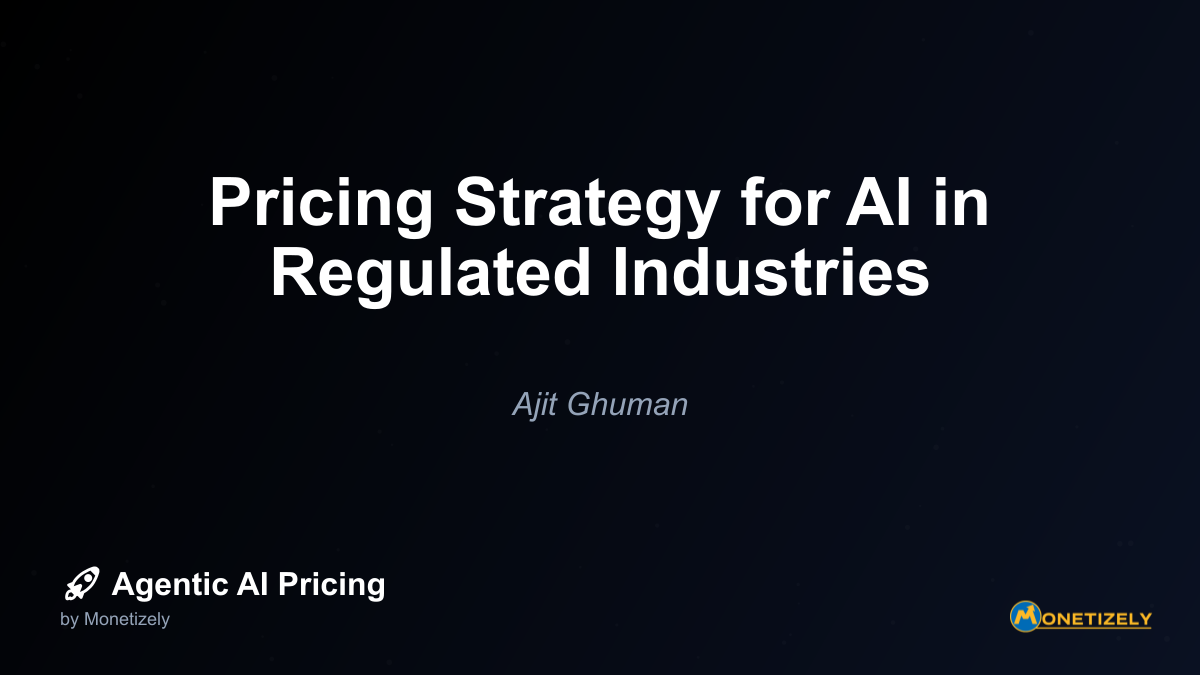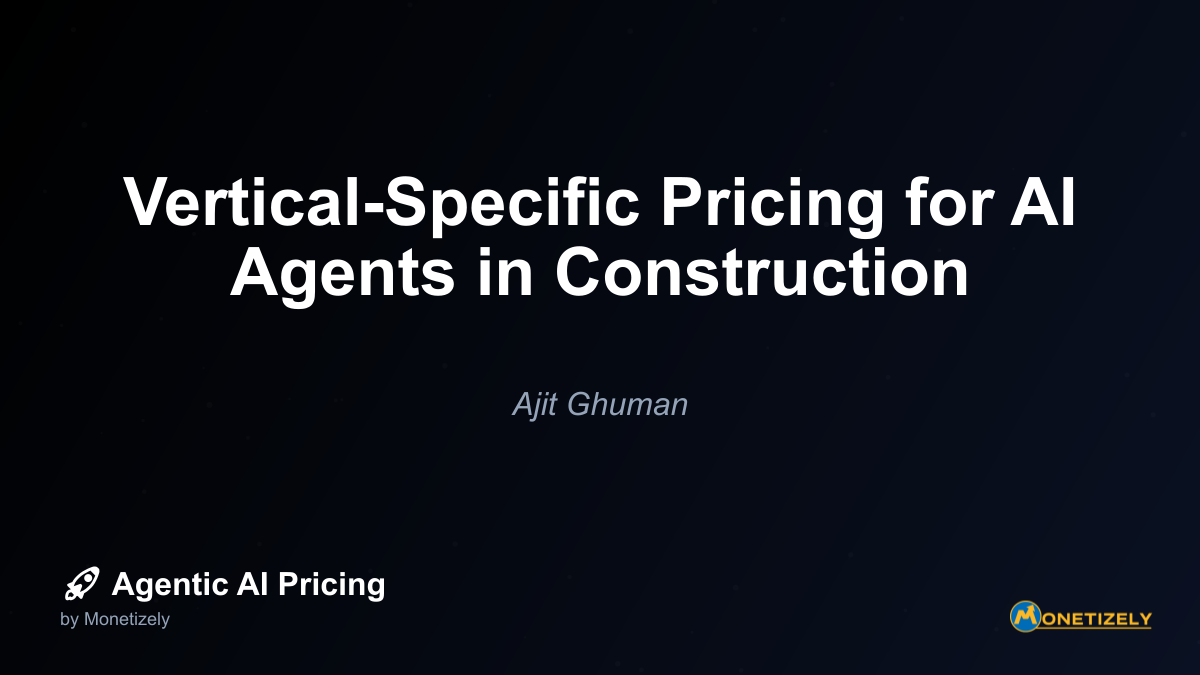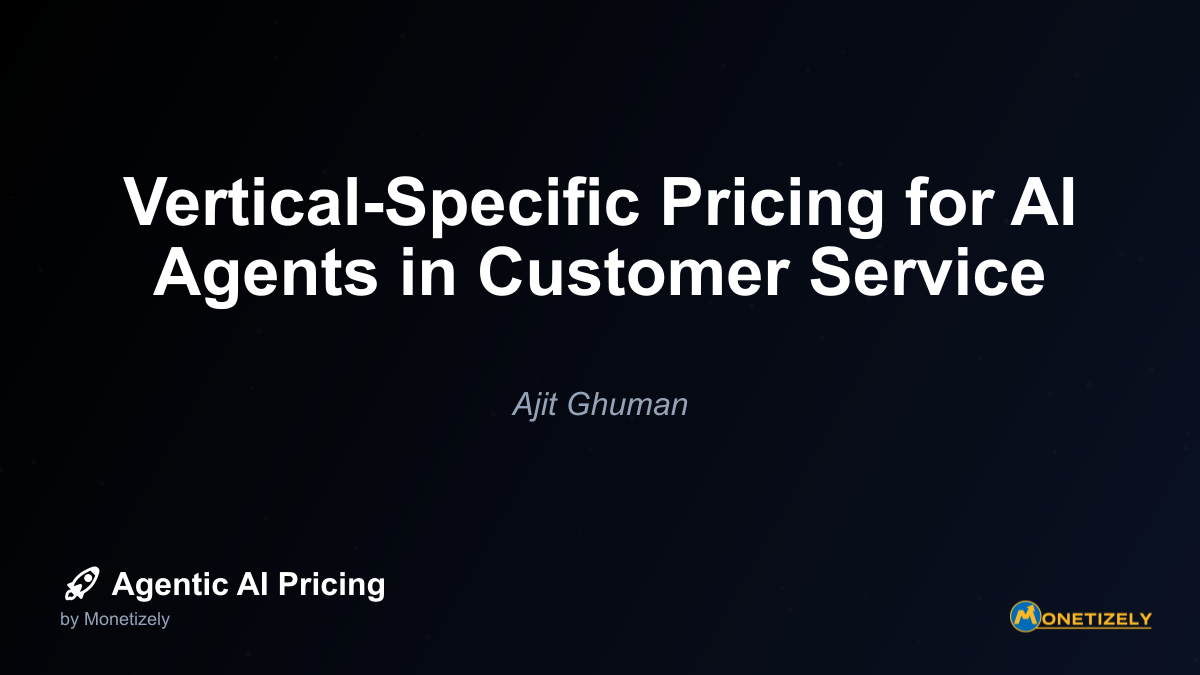· Ajit Ghuman · Industry-Specific · 12 min read
Vertical-Specific Pricing for AI Agents in Agriculture
AI and SaaS Pricing Masterclass
Learn the art of strategic pricing directly from industry experts. Our comprehensive course provides frameworks and methodologies for optimizing your pricing strategy in the evolving AI landscape. Earn a professional certification that can be imported directly to your LinkedIn profile.
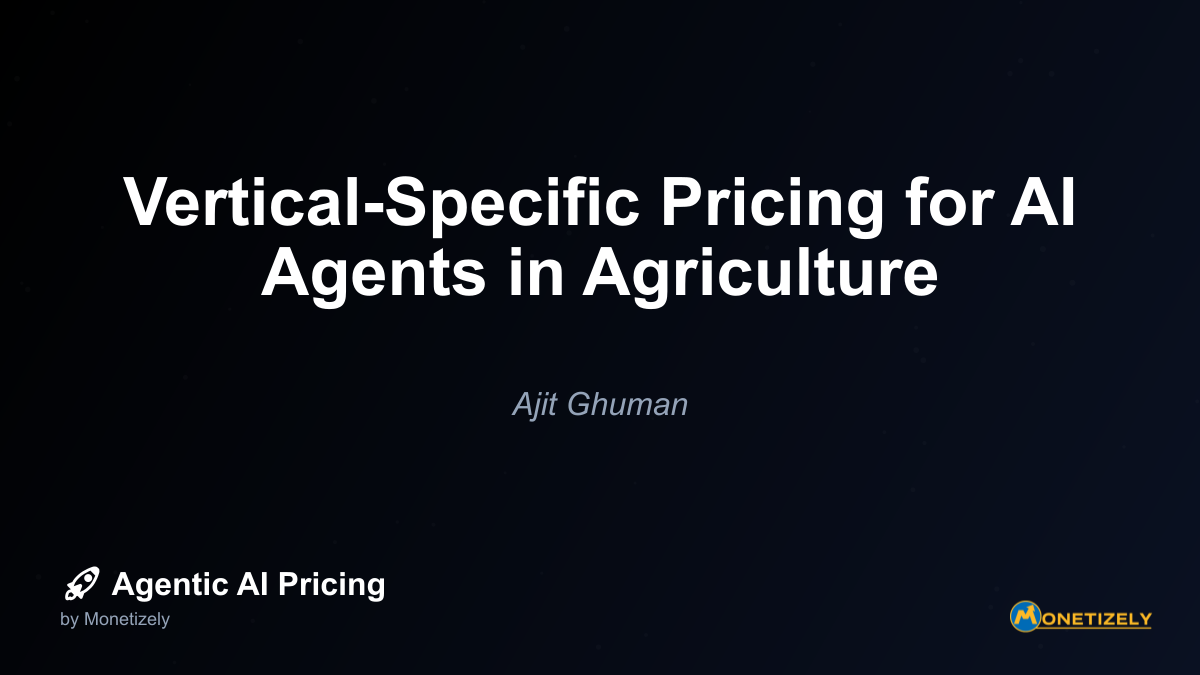
Precision agriculture has emerged as one of the most promising applications for artificial intelligence, transforming how farmers optimize yields and manage resources. The intersection of AI capabilities with agricultural needs has created a complex landscape of pricing models that must balance technological innovation, farm economics, and sustainable practices. This deep dive explores the nuanced approaches to pricing AI agents in agriculture, examining how different models serve various farm operations and what strategies maximize value for both technology providers and agricultural producers.
The Agricultural AI Revolution: Market Context and Growth Trajectory
The integration of AI into agricultural operations is accelerating rapidly, with global crop yields projected to increase by up to 20% by 2025 through AI-powered precision farming. This technological revolution is transforming traditional farming into data-driven operations that optimize every aspect of production. According to recent market analyses, AI applications in cropping and resource management are expected to reach adoption rates between 40-65% by 2025, with particularly strong uptake in crop monitoring (65%), predictive analytics for yield forecasting (59%), and precision irrigation (58%).
The economic impact is substantial—agricultural technology could reduce farming-related greenhouse gas emissions by up to 30% by 2030 if widely implemented. This environmental benefit translates directly to economic value through reduced input costs, improved yield consistency, and potential carbon credit monetization.
For technology providers, this represents an expanding market with diverse customer needs. Large-scale industrial farms, mid-sized operations, and smallholder farmers each require different pricing approaches that align with their operational scale, capital constraints, and expected returns on investment.
Core Pricing Models for Agricultural AI Agents
The agricultural sector presents unique challenges for AI pricing due to its seasonal nature, weather dependency, and varying farm scales. Several distinct pricing models have emerged to address these characteristics:
1. Subscription-Based Models
Subscription pricing has gained significant traction in agricultural AI, offering predictable recurring revenue for vendors while providing farmers with manageable operational expenses rather than large capital outlays.
Benefits for Farmers:
- Improved cash flow management aligned with seasonal income patterns
- Lower entry barriers compared to one-time purchases
- Regular updates and technological improvements
- Scalability to add or remove features as needs change
Examples in Practice:
- Companies like AGCO provide AI and autonomy technologies for agricultural equipment on subscription models to facilitate affordability
- Multi-tiered subscriptions enable smaller farms to choose basic functionality at lower cost while larger operations can access advanced features
One agricultural equipment manufacturer offers a base-tier subscription for $2,500 annually that includes AI-powered equipment diagnostics and basic yield forecasting, while their premium tier at $7,500 includes autonomous operation capabilities and advanced predictive maintenance.
2. Performance-Based and Harvest-Based Pricing
Perhaps the most innovative approach in agricultural AI pricing is the emergence of performance-based models that directly tie payment to measurable outcomes like yield increases or resource savings.
Key Features:
- Payment amounts vary depending on documented yield improvement or input cost reductions
- Risk-sharing between technology provider and farmer
- Strong alignment of incentives for successful technology deployment
Implementation Examples:
- Some providers offer pricing structures where fees adjust downward in poor harvest years and increase during exceptional performance years
- Yield monitoring technologies enable verification of improvements to support these models
A leading agricultural SaaS provider implements a harvest-based pricing model where the base subscription is $10 per acre annually, but this increases by $1 per acre for every 2% yield improvement above the farm’s historical baseline, capped at $18 per acre.
3. Data Monetization Partnerships
As data becomes increasingly valuable, some agricultural AI providers offer innovative pricing that incorporates data sharing arrangements.
Structure:
- Reduced fees to farmers in exchange for anonymized operational data
- Technology providers monetize aggregated insights and analytics
- Creates mutual value through data partnerships
Market Examples:
- Discounted access to AI tools in exchange for sharing soil, yield, and input data
- Clear contractual terms defining data ownership and usage rights
One precision agriculture platform reduces its standard $15,000 annual enterprise license to $8,000 for farms that agree to share anonymized soil sensor data, crop yield information, and equipment utilization metrics that the company aggregates for industry benchmarking products.
4. Tiered Pricing Based on Farm Size and Complexity
Recognizing the vast differences between small family farms and large industrial operations, many AI providers implement tiered pricing structures.
Implementation Approaches:
- Pricing tiers based on acreage covered
- Feature sets tailored to different operational scales
- Volume discounts for larger implementations
Market Examples:
- Small farm packages (under 500 acres) with essential features
- Mid-market solutions (500-5,000 acres) with expanded capabilities
- Enterprise-level packages (5,000+ acres) with comprehensive integration
One major agricultural AI provider structures its tiers as: Basic (up to 1,000 acres) at $5 per acre annually, Professional (1,000-10,000 acres) at $4 per acre, and Enterprise (10,000+ acres) at $3 per acre with additional customization options.
5. One-Time Purchase with Maintenance Fees
Despite the shift toward subscriptions, some agricultural AI solutions, particularly those embedded in hardware or requiring substantial customization, maintain one-time purchase models.
Characteristics:
- Higher upfront investment but potentially lower long-term costs
- Usually includes essential updates for a defined period
- May include annual maintenance fees for continued support
Examples in Practice:
- Companies like Ag Leader and Trimble offer agricultural software with AI features as one-time purchases
- These solutions typically report yield improvements up to 15% and productivity gains around 12%
A comprehensive farm management system with embedded AI capabilities might cost $25,000-50,000 as a one-time purchase with annual maintenance fees of 15-20% for updates and support.
Value-Based Pricing: Aligning Costs with Agricultural ROI
The agricultural sector’s thin margins and seasonal cash flow patterns make demonstrating clear return on investment essential for any AI pricing strategy. Successful pricing models in this space explicitly connect costs to tangible value creation.
Quantifying Value in Agricultural AI
Value in agricultural AI manifests in several forms that can be measured and incorporated into pricing models:
- Yield Increases: Direct production improvements through optimized inputs and timing
- Input Cost Reductions: Savings on water, fertilizer, pesticides, and labor
- Risk Mitigation: Reduced crop loss from pests, diseases, and weather events
- Quality Improvements: Better crop quality commanding premium prices
- Sustainability Benefits: Reduced environmental impact and regulatory compliance
ROI Calculation Frameworks
Enterprise-level agricultural AI implementations typically calculate ROI through:
- Percentage yield gain compared to historical baselines
- Per-hectare cost reduction in inputs
- Labor savings through automation and decision support
- Risk mitigation value (avoided crop losses)
- Long-term sustainability benefits and supply chain efficiency gains
A comprehensive ROI model might show that an AI-powered precision agriculture platform costing $50,000 annually for a 5,000-acre operation delivers:
- 8% yield increase worth $240,000 (assuming $600/acre revenue)
- 15% reduction in fertilizer and pesticide costs saving $75,000
- 20% irrigation efficiency improvement saving $30,000
- Labor savings of $45,000 through automation
- Total value creation of $390,000 against $50,000 cost (7.8x ROI)
Value Demonstration Methods
Agricultural AI providers employ several strategies to demonstrate value and justify their pricing:
- Pilot Projects: Limited implementations to establish baseline performance
- A/B Field Testing: Side-by-side comparisons of AI-managed versus traditionally managed fields
- Historical Comparisons: Before/after analysis of key performance indicators
- Predictive Modeling: Simulations showing expected outcomes under various scenarios
Enterprise agricultural AI solutions often include ROI calculators that allow potential customers to estimate value based on their specific operation parameters, creating transparency around the connection between pricing and expected returns.
Technical Implementation Considerations Affecting Pricing
The technical complexity of agricultural AI implementation significantly impacts pricing structures. Several factors influence implementation costs that must be reflected in pricing models:
Data Integration Challenges
Agricultural operations often have fragmented data sources that must be harmonized:
- Legacy farm management systems with proprietary data formats
- Multiple sensor networks with varying protocols
- Equipment from different manufacturers with incompatible telemetry
- Historical records in diverse formats (paper, spreadsheets, databases)
Integration costs can represent 30-50% of total implementation expenses for complex operations, necessitating pricing that accounts for these upfront investments.
Connectivity Limitations
Rural farming operations frequently face connectivity challenges:
- Limited broadband availability in agricultural regions
- Cellular coverage gaps across large fields
- Need for edge computing capabilities to function during connectivity outages
Solutions requiring significant edge computing capabilities or offline functionality often command premium pricing due to increased development complexity.
Hardware-Software Integration
Many agricultural AI solutions require specialized hardware:
- Soil sensors and weather stations
- Camera systems for crop monitoring
- Equipment retrofits for autonomous operation
- Custom IoT devices for specific applications
Pricing models must account for hardware components, installation, maintenance, and replacement cycles, often leading to hybrid pricing that separates hardware acquisition from software services.
Customization Requirements
Agricultural operations vary dramatically based on:
- Crop types and varieties
- Regional growing conditions
- Equipment fleets
- Management practices
- Scale of operations
Customization needs directly impact pricing, with highly tailored solutions commanding premium prices while more standardized offerings can be delivered at lower cost points.
Case Studies: Successful AI Pricing in Agriculture
Examining specific implementations provides valuable insights into effective pricing strategies for agricultural AI.
Case Study 1: Precision Irrigation AI Platform
Company Profile: An AI-driven irrigation management system using soil moisture sensors, weather data, and crop models.
Pricing Model: Tiered subscription with performance component
- Base fee: $8 per acre annually
- Tiered discounts: 5% at 1,000 acres, 10% at 5,000 acres, 15% at 10,000+ acres
- Performance bonus: 15% of documented water savings shared with the technology provider
Results:
- Average water savings of 25% across implementations
- ROI payback period of 12-18 months for most customers
- 92% customer retention rate
- Steady expansion of features funded by performance bonuses
Key Pricing Insight: The combination of scale-based pricing with performance incentives aligned vendor success with customer outcomes while creating predictable base revenue.
Case Study 2: Autonomous Equipment AI
Company Profile: AI system for retrofitting existing farm equipment with autonomous capabilities.
Pricing Model: Hardware purchase with tiered subscription
- One-time hardware cost: $15,000-25,000 per equipment unit
- Annual AI subscription: $2,500 for basic autonomy, $5,000 for advanced features
- Optional data sharing discount: 20% reduction for farms sharing operational data
Results:
- Labor cost reduction of 30-40% for participating farms
- Extended equipment operating hours (24/7 capability)
- Improved precision in field operations
- Rich dataset enabling continuous AI improvement
Key Pricing Insight: Separating hardware costs from AI capabilities allowed farmers to capitalize the physical components while treating the intelligence as an operational expense.
Case Study 3: Predictive Yield Optimization Platform
Company Profile: Comprehensive AI platform integrating multiple data sources to optimize planting, treatment, and harvesting decisions.
Pricing Model: Risk-sharing agreement
- Base subscription: $3 per acre
- Performance component: Additional $2-8 per acre based on yield improvements
- Risk protection: Fee reductions during documented crop failures or weather events
Results:
- Average yield improvements of 7-12%
- Strong customer loyalty due to risk-sharing during difficult seasons
- Continuous investment in AI capabilities funded by success fees
Key Pricing Insight: By sharing both upside potential and downside risk, the provider created a true partnership with farmers that increased adoption even among risk-averse operations.
Competitive Analysis: Major Players and Their Pricing Approaches
The agricultural AI market includes diverse participants from established agricultural companies to technology giants and innovative startups. Their pricing approaches reflect their market positioning and strategic objectives.
Traditional Agricultural Companies
Established agricultural companies like John Deere, AGCO, and CNH Industrial are integrating AI into their equipment and service offerings.
Typical Pricing Approaches:
- Bundling AI capabilities with equipment purchases
- Tiered subscription services for data analysis and decision support
- Integration with existing dealer networks and financing programs
Strategic Positioning:
- Leveraging established customer relationships and distribution
- Emphasizing integration with existing equipment fleets
- Focusing on practical, field-proven solutions
For example, John Deere offers its Operations Center platform with basic features free to equipment owners, while premium AI-powered features are available through tiered subscriptions ranging from $5-12 per acre annually.
Technology Giants
Major technology companies including Microsoft, Google, IBM, and Amazon have entered the agricultural AI space, often through partnerships with agricultural specialists.
Typical Pricing Approaches:
- Cloud-based, consumption-driven pricing models
- Integration with broader enterprise cloud services
- Platform approaches enabling third-party application development
Strategic Positioning:
- Leveraging advanced AI capabilities from other sectors
- Offering scalable infrastructure for agricultural applications
- Enabling ecosystem development through platforms and APIs
Microsoft’s FarmBeats platform, for instance, follows Azure’s consumption-based pricing model, charging for data storage, processing, and API calls rather than using agriculture-specific metrics.
Agricultural AI Startups
Innovative startups are developing specialized AI solutions for specific agricultural challenges.
Typical Pricing Approaches:
- Outcome-based pricing tied directly to measurable results
- Freemium models to drive adoption
- Strategic partnerships with established agricultural companies
Strategic Positioning:
- Focusing on specific high-value problems
- Emphasizing agility and innovation
- Building credibility through demonstrated results
One startup focusing on AI-powered pest detection offers a freemium model where basic monitoring is free, but automated treatment recommendations and integration with sprayer systems requires a premium subscription of $3-7 per acre depending on crop type and pest pressure.
Vertical-Specific Challenges in Agricultural AI Pricing
Agriculture presents unique vertical-specific challenges that impact AI pricing strategies.
Seasonal Cash Flow Patterns
Unlike many industries with steady revenue streams, farming operations typically generate most of their income during harvest periods, creating cash flow mismatches with monthly subscription models.
Pricing Adaptations:
- Annual billing aligned with harvest timing
- Flexible payment schedules matching crop sales
- Financing options integrated with pricing models
Some providers offer “harvest pay” options where the bulk of annual fees are due after crop sales, with minimal payments during growing seasons.
Weather and Climate Risk
Agricultural outcomes are heavily influenced by weather and climate conditions beyond farmers’ control, creating risk factors that must be considered in pricing.
Pricing Adaptations:
- Risk-sharing components that adjust fees based on weather impacts
- Integration with crop insurance products
- Force majeure clauses for extreme events
One innovative approach ties a portion of AI service fees to weather conditions, automatically reducing charges during drought or excessive rainfall periods that limit the technology’s effectiveness.
Varying Farm Scales and Technological Readiness
The agricultural sector encompasses operations ranging from small family farms to massive industrial producers, with vastly different technology adoption capabilities.
Pricing Adaptations:
- Entry-level packages designed for smaller operations
- Cooperative or group purchasing options for small farms
- Enterprise-grade solutions for large operations with dedicated IT resources
Some providers facilitate cooperative purchasing where multiple small farms collectively subscribe to services, gaining access to technology that would be unaffordable individually.
Data Ownership and Privacy Concerns
Agricultural data has significant value beyond individual farm operations, creating complex questions around data ownership and monetization rights.
Pricing Adaptations:
- Transparent data usage policies tied to pricing options
- Premium pricing for enhanced data privacy
- Value-sharing for data monetization
Clear contracts defining data ownership rights and usage limitations have become standard, with pricing often reflecting different data sharing arrangements.
Future Trends in Agricultural AI Pricing
Several emerging trends are likely to shape the future of pricing models for agricultural AI:
1. Blockchain-Enabled Transparent Value Sharing
Blockchain technology is beginning to impact agricultural AI pricing by enabling transparent, verifiable tracking of outcomes and value creation.
Emerging Applications:
- Smart contracts that automatically adjust payments based on verified results
- Tokenized value sharing for data contributions
- Immutable record-keeping for performance-based pricing
This technology could reduce verification costs and increase trust in performance-based pricing models, potentially making them more widespread.
2. Climate-Adaptive Pricing
As climate change increases agricultural volatility, pricing models are evolving to incorporate climate resilience factors.
Developing Approaches:
- Premium discounts for implementing climate-adaptive practices
- Risk-adjusted pricing based on climate vulnerability assessments
- Integration with carbon markets and sustainability incentives
One forward-thinking provider adjusts subscription costs based on the farm’s implementation of climate-resilient practices, recognizing that these improve the AI system’s effectiveness.
3. Ecosystem-Based Pricing
Rather than pricing individual AI applications separately, there’s a trend toward ecosystem pricing that encompasses multiple integrated technologies.
Key Features:
- Bundle discounts for complementary AI tools
- Unified data platforms serving multiple applications
- Ecosystem partnerships with coordinated pricing
This approach recognizes that the value of agricultural AI often increases dramatically when multiple systems work together seamlessly.
4. Smallholder-Accessible Models
Innovative pricing approaches are emerging to make advanced agricultural AI accessible to smallholder farmers who represent the majority of global agricultural producers.
Innovative Approaches:
- Microsubscription models with very low entry costs
- Mobile-first solutions with pay-as-you-go pricing
- Group access models through cooperatives or associations
By adapting pricing to smallholder realities, providers can access massive markets
Co-Founder & CEO
Ajit is the author of Price To Scale, a top book on SaaS Pricing and is the Founder of Monetizely. Ajit has led and worked in pricing and product marketing at firms like Twilio, Narvar and Medallia. His work has been featured in Forbes and VentureBeat. Ajit regularly consults with software companies from Seed stage to post-IPO on pricing strategy. Ajit is also a highly-rated co-instructor for 'The Art of SaaS Pricing and Monetization' on Maven.
Pricing Strategy Audit
Let our experts analyze your current pricing strategy and identify opportunities for improvement. Our data-driven assessment will help you unlock untapped revenue potential and optimize your AI pricing approach.

